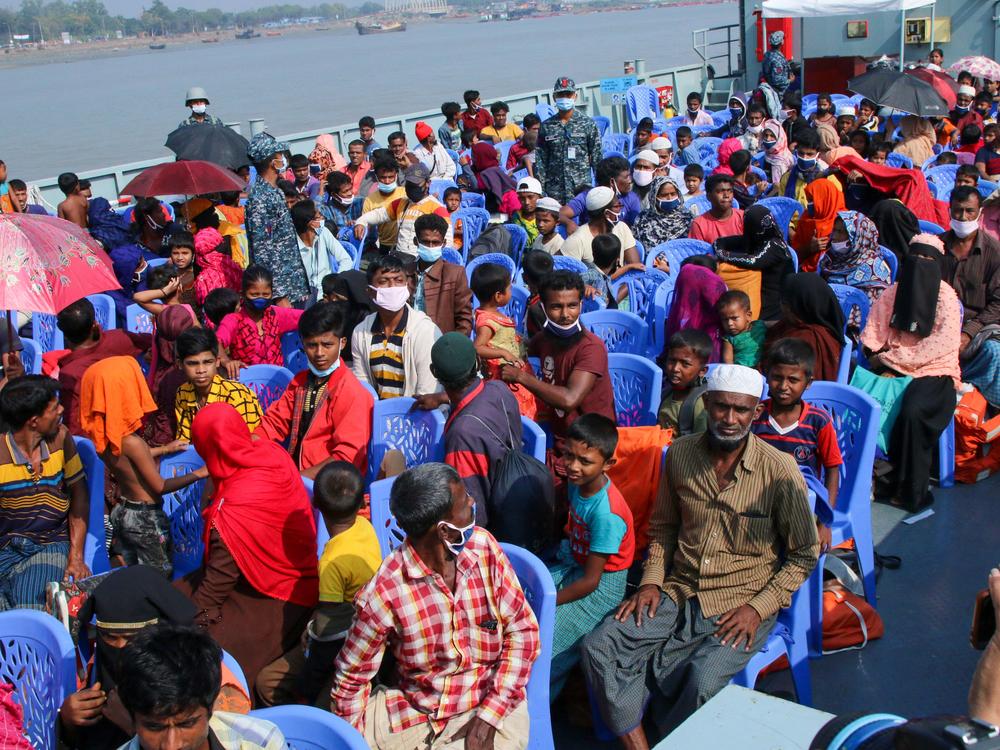Section Branding
Header Content
Bangladesh Begins Moving Displaced Rohingya Muslims To Island
Primary Content
Authorities in Bangladesh are pushing ahead with the relocation of tens of thousands of Rohingya Muslims to a remote island in the Bay of Bengal, despite concerns raised by human rights groups and the United Nations.
On Thursday, the first group of about 1,500 Rohingya were placed aboard several navy vessels heading toward to Bhashan Char, located about 120 miles south of the capital, Dhaka.
Bangladeshi officials first proposed the island in 2015 as an option for some of the hundreds of thousands who have been housed for years in camps since fleeing brutal crackdowns by the military in neighboring Myanmar. But the idea was put on hold because of potentially unsafe conditions on the cyclone and flood-prone island.
Phil Robertson, the deputy Asia director for Human Rights Watch, likens the island to "a de facto prison island. It's like the Rohingya Alcatraz."
Robertson says, "There's concerns about health, there's concerns about medical services, there's concern about adequate amounts of food and other supplies. I mean, it's a disaster waiting to happen."
The U.N. said Wednesday that it is aware of reports of Bangladeshi authorities starting the relocation process, but said it had not reviewed the operation before hand.
The U.N. said any relocation plan for Bhashan Char should involve a review of the safety, feasibility, and sustainability of the island for refugees to live and should involve the full consent of the Rohingya.
"The United Nations has not been involved in preparations for this movement or the identification of refugees and has limited information on the overall relocation exercise," the U.N. said.
Amnesty International called on Bangladesh to halt the relocation altogether, saying that authorities should "return those on the island to their families and community in mainland Bangladesh, and follow due process including the full and meaningful participation of refugees in any plan for their relocation."
About 1 million Rohingya live in a massive refugee camp in Cox's Bazar in Bangladesh, unable or unwilling to go back to Myanmar, according to the U.N.
Although many Rohingya came to Bangladesh in the preceding years, most were forced to flee from Myanmar's western Rakhine state in 2017 during a systematic campaign by the army against them. The military is accused of war crimes that include rape, murder, and the destruction of thousands of homes. Myanmar has denied those allegations.
Bangladeshi officials say Bhashan Char was renovated to safely accommodate 100,000 people—a fraction of the roughly 1 million refugees that could be moved. At a cost of more than $100 million, the Bangladeshi Navy built houses, hospitals, and mosques and retrofitted the island with flood protection.
Rights groups, the U.N., and foreign media have not been allowed to visit the island. Humans Rights Watch and the group Fortify Rights said early evidence shows the Bangladeshi government may be forcing the Rohingya to go to the island or are luring them under false pretenses.
"The government has provided limited information to refugees about the actual conditions on the island, and there are some allegations that the authorities may have offered misleading information and incentives to move there," Human Rights Watch said.
More than 300 Rohingya currently live on the island and say they are denied freedom of movement and have no access to sustainable jobs or an education, the group said.
A man told Human Rights Watch that he volunteered only after he was told those on the list would be given priority to repatriate to Myanmar and would be paid.
And a 50-year-old woman from the Kutapalong camp told NPR her name was put on the list without her knowledge. Local elders told her she had no choice. But she's refused and has decided to hide to avoid having to go.
She said, "My son isn't going, so if I get sick, who would take care of me? I don't want to die in the middle of the ocean."
NPR's Michael Sullivan contributed to this report.
Copyright 2020 NPR. To see more, visit https://www.npr.org.

